
Lasiopetalum maxwellii is a species of flowering plant in the family Malvaceae and is endemic to the south coast Western Australia. It is a sprawling shrub with hairy young stems, lance-shaped to oblong leaves and white to cream-coloured flowers.

Leionema elatius, commonly known as tall phebalium, is a shrub species that is endemic to New South Wales and Queensland in Australia. It has glossy green, variably-shaped leaves and clusters of white-lemon flowers in spring.
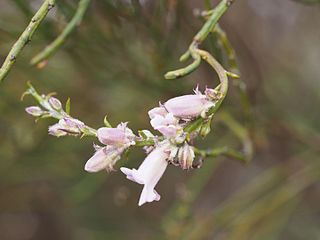
Eremophila dempsteri is a flowering plant in the figwort family, Scrophulariaceae and is endemic to the south of Western Australia. It is an erect shrub with many upright stems, short, hooked leaves and pinkish-purple to white flowers with distinctive woolly sepals.

Pityrodia chrysocalyx is a flowering plant in the mint family Lamiaceae and is endemic to the south-west of Western Australia. It is an erect, bushy shrub with small, glossy leaves, and flowers with white petals and a golden-yellow calyx.
Thryptomene elliottii is a species of flowering plant in the family Myrtaceae and is endemic to southern central Australia. It is a shrub with decussate, egg-shaped to club-shaped leaves and pink or white flowers with five petals and five stamens.

Leucopogon plumuliflorus is a species of flowering plant in the heath family Ericaceae and is endemic to the south-west of Western Australia. It is a weakly erect shrub with egg-shaped leaves and spikes of white or pinkish-white, tube-shaped flowers.

Styphelia crassifolia is a species of flowering plant in the family Ericaceae and is endemic to [the south-west of Western Australia. It is an erect, bushy shrub that typically grows to a height of 60 cm (24 in). Its leaves are oblong, 4–9 mm (0.16–0.35 in) long on a short petiole, with 3 prominent ribs on the lower surface. One or two flowers are borne in leaf axils on a short peduncle with tiny bracts and bracteoles about half the length of the sepals. The sepals are about 1.6 mm (0.063 in) long and the petals are about 3.2 mm (0.13 in) long and joined at the base, the lobes about as long as the tube.

Rhadinothamnus euphemiae, is a slender, small, upright shrub with needle-shaped branchlets thickly covered with silvery scales and tubular greenish-purple tubular flowers throughout the year. It is endemic to the south coast of Western Australia.
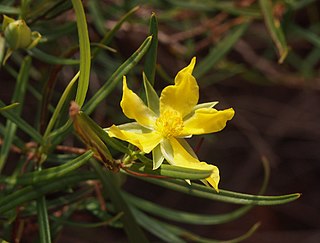
Hibbertia glaberrima is a species of flowering plant in the family Dilleniaceae and is endemic to Central Australia. It is a glabrous, spreading shrub with oblong to lance-shaped leaves and yellow flowers borne singly in upper leaf axils, with 30 to 150 stamens arranged around three carpels.
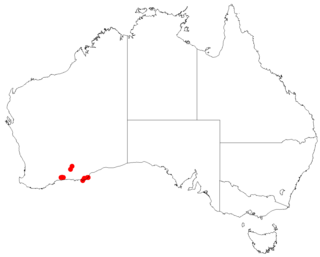
Leucopogon bossiaea is a species of flowering plant in the heath family Ericaceae and is endemic to a restricted area in the south-west of Western Australia. It is an erect shrub with elliptic to broadly egg-shaped leaves and white flowers in four to eleven upper leaf axils.

Styphelia blepharolepis is a species of flowering plant in the heath family Ericaceae and is endemic to the south-west of Western Australia. It is an erect shrub with sharply-pointed, oblong to lance-shaped leaves and small flowers in racemes of two to five in leaf axils with small bracts and bracteoles about 1 mm (0.039 in) long. The sepals are about 2 mm (0.079 in) long and the petals are joined at the base forming an urn shape about 4 mm (0.16 in) long with lobes longer than the petal tube.
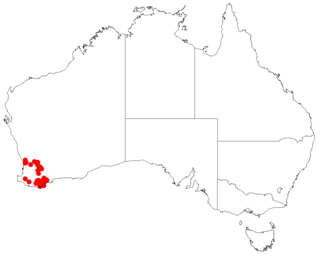
Styphelia cymbiformis is a flowering plant in the family Ericaceae and is endemic to the south-west of Western Australia. It is a bushy or wiry shrub that typically grows to a height of 30–50 cm (12–20 in) and has more or less glabrous branches. Its leaves are erect, linear to lance-shaped and sharply-pointed, mostly 2–4 mm (0.079–0.157 in) long. The flowers are arranged in short spikes, sometimes of only two or three flowers, with lance-shaped, leaf-like bracts, and bracteoles half as long as the sepals at the base of the spikes. The sepals are 2.5–3.0 mm (0.098–0.118 in) long and the petals slightly longer than the sepals, the lobes shorter than the petal tube.

Styphelia flavescens is a species of flowering plant in the heath family Ericaceae and is endemic to the south-west of Western Australia. It is a shrub with oblong leaves and white, tube-shaped flowers that are densely bearded on the inside.
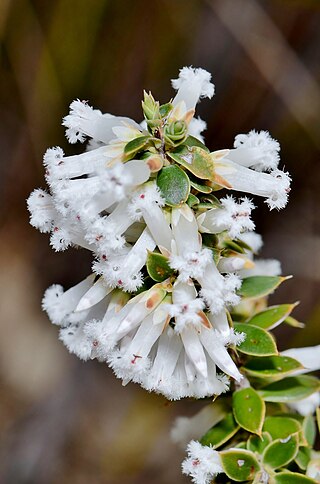
Styphelia erubescens is a species of flowering plant in the heath family Ericaceae and is endemic to the south-west of Western Australia. It is an erect shrub with variably-shaped leaves with a small, sharp point on the tip, and white, pink or red, tube-shaped flowers.

Brachyloma depressum, commonly known as spreading brachyloma or spreading heath, is a species of flowering plant in the family Ericaceae and is endemic to south-eastern Australia. It is a stiff, prickly shrub with sharply-pointed, lance-shaped leaves and white, tube-shaped flowers.
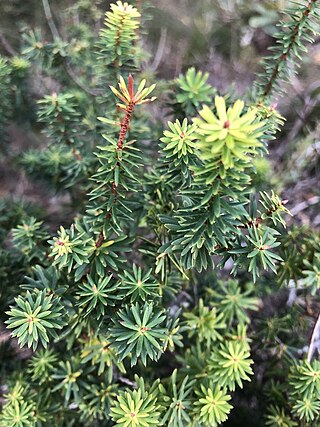
Brachyloma scortechinii is a species of flowering plant in the family Ericaceae and is endemic to eastern Australia. It is a shrub with narrowly oblong or oblong leaves and translucent, bulbous cylindrical flowers.
Styphelia exserta is a species of flowering plant in the heath family Ericaceae and is endemic to the south-west of Western Australia. It is an erect shrub with broadly egg-shaped leaves, and white, tube-shaped flowers.

Styphelia hainesii is a species of flowering plant in the heath family Ericaceae and is endemic to the south coast of Western Australia. It is a bushy shrub with egg-shaped leaves, the narrower end towards the base, and red, tube-shaped flowers arranged singly in leaf axils.

Styphelia lissanthoides is a species of flowering plant in the heath family Ericaceae and is endemic to the south of Western Australia. It is an erect, bushy shrub with egg-shaped to lance-shaped leaves with the narrower end towards the base, and white, tube-shaped flowers arranged singly or in pairs in leaf axils.

Lissanthe pluriloculata is a species of flowering plant in the family Ericaceae and is endemic to Queensland. It is a small, bushy shrub with sharply-pointed linear leaves and spikes or racemes of tube-shaped, white flowers.

















